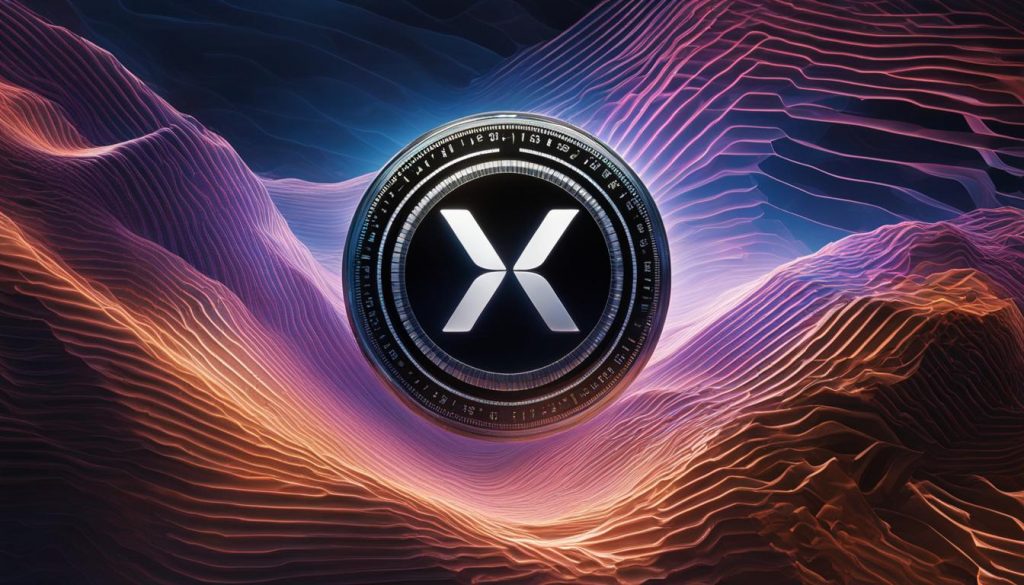The XRP project, developed by Ripple Labs, has a clear and ambitious purpose: to revolutionize cross-border payments and remittances. With its innovative technology and forward-thinking vision, the XRP project aims to provide a faster, more cost-effective, and streamlined option for conducting international transactions.
Through its payment network, RippleNet, XRP facilitates quick and affordable transfers, eliminating the inefficiencies of traditional systems like SWIFT. The project’s mission is to transform the global financial system by utilizing blockchain technology and providing seamless, transparent, and near-instantaneous settlement for cross-border payments.
Key Takeaways:
- The XRP project aims to revolutionize cross-border payments and remittances.
- Ripple Labs developed the XRP project to provide faster and more cost-effective international transactions.
- Through RippleNet, XRP offers seamless, transparent, and near-instantaneous settlement.
- The project’s mission is to transform the global financial system using blockchain technology.
- XRP eliminates the inefficiencies of traditional systems like SWIFT.
Ripple’s Disruption of Cross-Border Payments
RippleNet, the payment network built by Ripple Labs, is revolutionizing cross-border payments and remittances by leveraging blockchain technology. With its faster transaction processing and cost-effective transfers, RippleNet is challenging the traditional systems like SWIFT and providing a more streamlined option for conducting international transactions.
Unlike traditional systems that require multiple intermediaries and can take days to settle transactions, RippleNet enables near-instantaneous settlement, reducing the time and cost associated with cross-border payments. By utilizing blockchain technology, RippleNet eliminates the need for lengthy clearing and settlement processes, making transactions quicker and more efficient.
Transaction transparency is another significant advantage of RippleNet. Through its distributed ledger technology, all parties involved in a transaction can have visibility into the entire payment process. This transparency enhances trust and reduces the risk of fraudulent activities, making cross-border payments more secure.
The adoption of blockchain technology and RippleNet’s disruptive approach to cross-border payments have the potential to revolutionize the global financial system, making transactions faster, more affordable, and transparent. By eliminating the inefficiencies of traditional systems and providing near-instantaneous settlement, RippleNet is paving the way for a more connected and accessible global economy.
In conclusion, Ripple’s disruptive impact on cross-border payments is driven by its innovative use of blockchain technology, faster transaction processing, cost-effective transfers, transaction transparency, and near-instantaneous settlement. As RippleNet continues to gain traction in the financial industry, it has the potential to reshape the future of international transactions and remittances, benefiting both financial institutions and individuals with its streamlined and secure payment network.

The Origins of Ripple
Ripple, initially launched as XRP Ledger in 2012, was developed by computer engineers David Schwartz, Jed McCaleb, and Arthur Britto. It was created as a sustainable system for value transfer without relying on mining processes. Over time, the separate entities of Ripple, including XRP Ledger and RippleNet, converged into the Ripple ecosystem. The project’s founders played crucial roles in its development, with Jed McCaleb later leaving to create Stellar (XLM). XRP tokens were pre-mined, with a portion held by Ripple and released gradually to support liquidity and market growth.
Throughout the history of Ripple, the company has been dedicated to providing efficient and secure financial solutions. The development of the XRP Ledger and the Ripple Transaction Protocol allowed the project to advance its mission of transforming the global financial system. Ripple’s founders recognized the limitations of traditional cross-border payment systems and sought to create a seamless, transparent, and near-instantaneous settlement process.
“Ripple aims to revolutionize the way cross-border payments and remittances are conducted by utilizing blockchain technology and providing faster, more cost-effective transfers.”
The creation of the XRP token as the native cryptocurrency of the Ripple ecosystem was a significant milestone. It serves as a bridge currency, providing liquidity for exchanges between fiat currencies and other cryptocurrencies. While critics raise concerns about XRP being pre-mined, Ripple’s gradual release strategy ensures a controlled supply that supports market stability.
Table: Key Milestones in the History of Ripple
| Year | Event |
|---|---|
| 2012 | Ripple (XRP Ledger) launched |
| 2013 | Ripple Transaction Protocol introduced |
| 2015 | RippleNet payment network established |
| 2016 | XRP token becomes the native cryptocurrency of Ripple |
| 2020 | SEC files lawsuit against Ripple regarding XRP token sales |
XRP’s Role in Ripple

XRP plays a crucial role within the Ripple ecosystem, serving as a bridge currency and liquidity provider. While Ripple’s payment network, RippleNet, allows for the seamless transfer of various currencies and assets, XRP serves as a valuable intermediary for transactions that require on-demand liquidity.
As a bridge currency, XRP enables the immediate exchange of different fiat currencies and cryptocurrencies. This functionality eliminates the need for multiple conversions and reduces transaction costs and settlement times. By leveraging XRP as an exchange mechanism, financial institutions can unlock the benefits of faster transactions and enhanced liquidity.
“XRP’s role as a bridge mechanism has led to regulatory scrutiny, including a lawsuit by the SEC alleging that XRP sales constituted unregistered securities offerings by Ripple.”
However, it is important to note that Ripple is currently facing a lawsuit from the U.S. Securities and Exchange Commission (SEC) regarding the classification of XRP as a security. This regulatory challenge has brought attention to the distinction between XRP and Ripple as separate entities. The outcome of the lawsuit will have significant implications for the future of XRP and its role within Ripple’s ecosystem.
The SEC Lawsuit Against Ripple
The SEC alleges that Ripple conducted an unregistered securities offering through the sale of XRP tokens. The lawsuit argues that XRP should be classified as a security, subject to the regulatory requirements imposed on securities offerings. Ripple, on the other hand, contends that XRP should be recognized and regulated as a cryptocurrency, like Bitcoin or Ethereum.
The ongoing legal battle between Ripple and the SEC has brought uncertainty to the XRP market and raised questions about its role within the broader cryptocurrency landscape. The outcome of the lawsuit will not only impact Ripple and XRP but may also set a precedent for future regulatory actions against other cryptocurrencies.
Table: Pros and Cons of XRP’s Role in Ripple
| Pros | Cons |
|---|---|
| Facilitates quick and cost-effective currency exchange | Regulatory uncertainty due to ongoing SEC lawsuit |
| Enhances liquidity for cross-border transactions | Potential impact on Ripple’s business operations |
| Enables near-instantaneous settlement | Potential implications for the broader cryptocurrency industry |
| Reduces dependency on traditional banking systems | Risk of increased scrutiny from regulatory authorities |
Understanding XRP and its Advantages
The XRP cryptocurrency operates on the XRP Ledger, a highly secure and decentralized blockchain network. This ledger serves as an immutable record of all transactions and balances, ensuring transparency and reliability. One of the key advantages of XRP is the speed of transaction confirmations. Unlike traditional banking systems that can take days to process international transfers, XRP transactions settle within seconds, providing near-instantaneous settlement for cross-border payments.
At the core of the XRP Ledger is a consensus protocol that ensures the validity of transactions. This consensus protocol relies on a network of trusted validators to reach agreement on the order and validity of transactions. The robustness of this protocol prevents double-spending and ensures the integrity of the network.
In addition to its speed and security, XRP transactions offer low fees compared to traditional payment systems. This makes it an attractive option for both individuals and financial institutions, allowing them to save costs on international transfers. The scalability of the XRP Ledger is another advantage, with the ability to handle a high volume of transactions per second, making it well-suited for global adoption.
Furthermore, XRP has green attributes that differentiate it from other cryptocurrencies. Unlike the energy-intensive mining process used by some cryptocurrencies, XRP was pre-mined, meaning the entire supply was created at once. This eliminates the need for ongoing mining and reduces the environmental impact associated with cryptocurrency production.
Conclusion
The XRP project, developed by Ripple Labs, has a clear purpose – to revolutionize cross-border payments and remittances. Through its RippleNet payment network and XRP cryptocurrency, it aims to provide faster, more cost-effective, and transparent transactions for financial institutions and individuals worldwide.
Despite regulatory challenges and ongoing litigation, Ripple’s XRP project continues to offer significant benefits. By utilizing blockchain technology, XRP enables near-instantaneous settlement, transaction transparency, and low fees. Its scalability and green attributes further enhance its appeal.
Looking ahead, the future of XRP remains uncertain. However, its innovative approach to cross-border payments and its potential to shape the global financial system make it a digital currency to watch. As Ripple continues to evolve and navigate regulatory matters, the benefits of the XRP project cannot be overlooked.
FAQ
What is the purpose of the XRP project?
The purpose of the XRP project, developed by Ripple Labs, is to revolutionize cross-border payments and remittances by providing a faster, more cost-effective, and streamlined option for conducting international transactions.
How does Ripple’s RippleNet disrupt cross-border payments?
Ripple’s RippleNet offers an alternative to the SWIFT network for cross-border funds transfer. By utilizing blockchain technology, RippleNet eliminates the multiple layers required by SWIFT, enabling end-to-end transfer processes that take only minutes. It provides transaction transparency and near-instantaneous settlement status, revolutionizing the efficiency and cost-effectiveness of cross-border payments and remittances.
What are the origins of Ripple?
Ripple, initially launched as XRP Ledger in 2012, was developed by computer engineers David Schwartz, Jed McCaleb, and Arthur Britto. It was created as a sustainable system for value transfer without relying on mining processes. Over time, the separate entities of Ripple, including XRP Ledger and RippleNet, converged into the Ripple ecosystem.
What is the role of XRP in Ripple?
XRP serves as the native cryptocurrency of the Ripple ecosystem. While any currency or asset can be used for transactions on the Ripple network, XRP acts as a bridge currency when necessary. It provides liquidity for exchanges between fiat currencies and other cryptocurrencies.
What are the advantages of XRP?
XRP operates on the XRP Ledger, a blockchain that maintains an immutable record of transactions and balances. Transactions settle within seconds, providing quick confirmations and allowing payments in local currencies for both parties. XRP offers advantages such as low transaction fees, scalability with high transaction capacity, and its inherently green attributes.
What is the future of XRP?
The future of XRP remains uncertain but holds the potential to shape the future of global financial transactions. Despite regulatory challenges and ongoing litigation, Ripple’s XRP project continues to be a significant player in the digital currency space.




